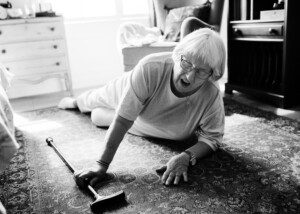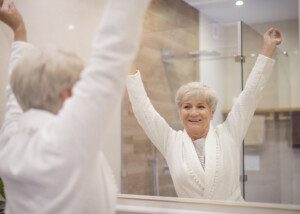For extra heavy seniors, a slow-down in movement can lead to serious concerns — especially frailty.
Frailty interferes with the ability to lead an independent life.
Frailty is a medical term: a decline in physical strength and function that makes it harder to recover from everyday stresses.
It can increase the risk of falls, hospital stays and dependence on others for everyday tasks.
Your body may be getting frail if you’re moving slower than usual, feeling weaker or less steady, and have become less active/more sedentary.
Frailty doesn’t have to occur just because you’re over 60.
But if your doctor has confirmed that your body has become medically frail – this is often reversible.
One of the simplest and most effective ways to fight back is through walking.
NOW – you might be thinking, “But I already walk. I have no choice with my job (or whatever may be the reason such as having a dog or doing volunteer work).”
But it’s not always how often you walk throughout the day. It’s how fast, and this includes short distances, even room-to-room between long periods of sitting.
The speed is the change that will make a big difference in your health, stamina and mobility, even if you’re heavy-set.
Finding the Right Walking Pace
In the past, doctors often recommended the “talk test” to gauge walking intensity: Walk at a pace that makes it tough to sing your favorite tunes but still allows for comfortable conversation.
It’s a helpful starting point—but it’s also subjective and not easy to track.
Research from the University of Chicago Medicine offers a clearer approach.
Their study found that older adults who increased their walking pace by just 14 steps per minute above their usual speed saw noticeable improvements in physical ability — even those who were frail or at risk of becoming frail.
Why focus on steps per minute?
Walking cadence — the number of steps taken per minute — is a simple, measurable way to track walking intensity.
Dr. Daniel Rubin, an anesthesiologist at UChicago Medicine, decided to study this because of the challenges he saw among older surgical patients, many with obesity or mobility issues.
His paper points out that questionnaires aren’t really all that reliable due to their subjectivity: the patient’s perspective.
What is needed is a measuring approach that’s objective.
That led to studies focused on how walking pace can be a powerful marker of physical health in older adults.
Faster Steps, Stronger Bodies
In their clinical trial, Dr. Rubin’s team worked with older adults classified as frail or on the cusp of becoming frail.
Participants joined structured walking programs inside their living communities.
Some walked at a casual pace, while others were encouraged to walk as quickly as they can safely carry out.
Those who increased their cadence or speed by just 14 steps per minute — reaching around 100 steps per minute total — were able to walk for longer distances and also showed clear improvements in strength and stamina.
Efficient walking is the cornerstone of preserving independence into old age.
Putting It into Practice
You don’t need to become a marathon walker to see benefits. Here’s how to start integrating purposeful walking into your daily life:
Find your baseline: Use a stopwatch or app to count how many steps you take in one minute at your normal pace.
I myself used the old-fashioned way: In my head I counted the steps I took, at varying speeds, on my treadmill for one minute.
So for instance, I know that at 2 mph, I will have completed about 6,700 steps in 60 minutes, or 112 steps per minute.
Height, natural stride, body weight and other variables will play into how many steps you can comfortably do in one minute, 30 minutes or an hour nonstop.
You can always go a little faster than your usual or baseline speed or cadence.
Increase gradually: Add about 14 steps per minute above your baseline. If you normally take 86 steps per minute, aim for 100.
Stay within a reasonable range: You should feel like you’re pushing yourself slightly or a bit outside your comfort zone, but not to the point of discomfort or especially pain (e.g., if you have plantar fasciitis, you should not do anything that aggravates this).
Use tools: A metronome app or simple timer can help you stay on pace.
Stay consistent: Even 10-15 minutes of faster-paced walking a day can lead to big improvements over time.
![]()
Lorra Garrick is a former personal trainer certified by the American Council on Exercise. At Bally Total Fitness, where she was also a group fitness instructor, she trained clients of all ages and abilities for fat loss and maintaining it, muscle and strength building, fitness, and improved cardiovascular and overall health.










































